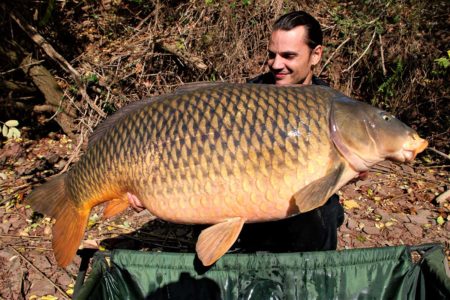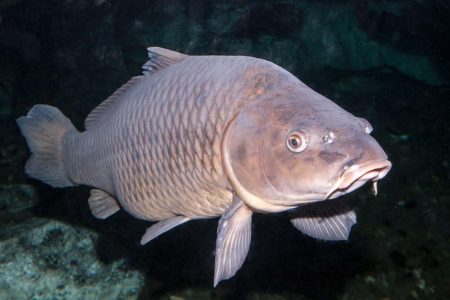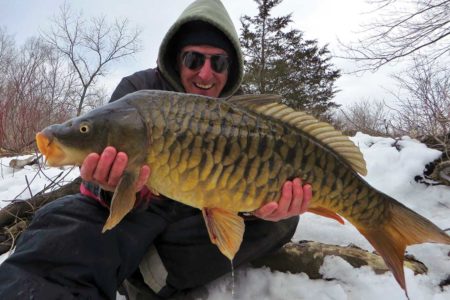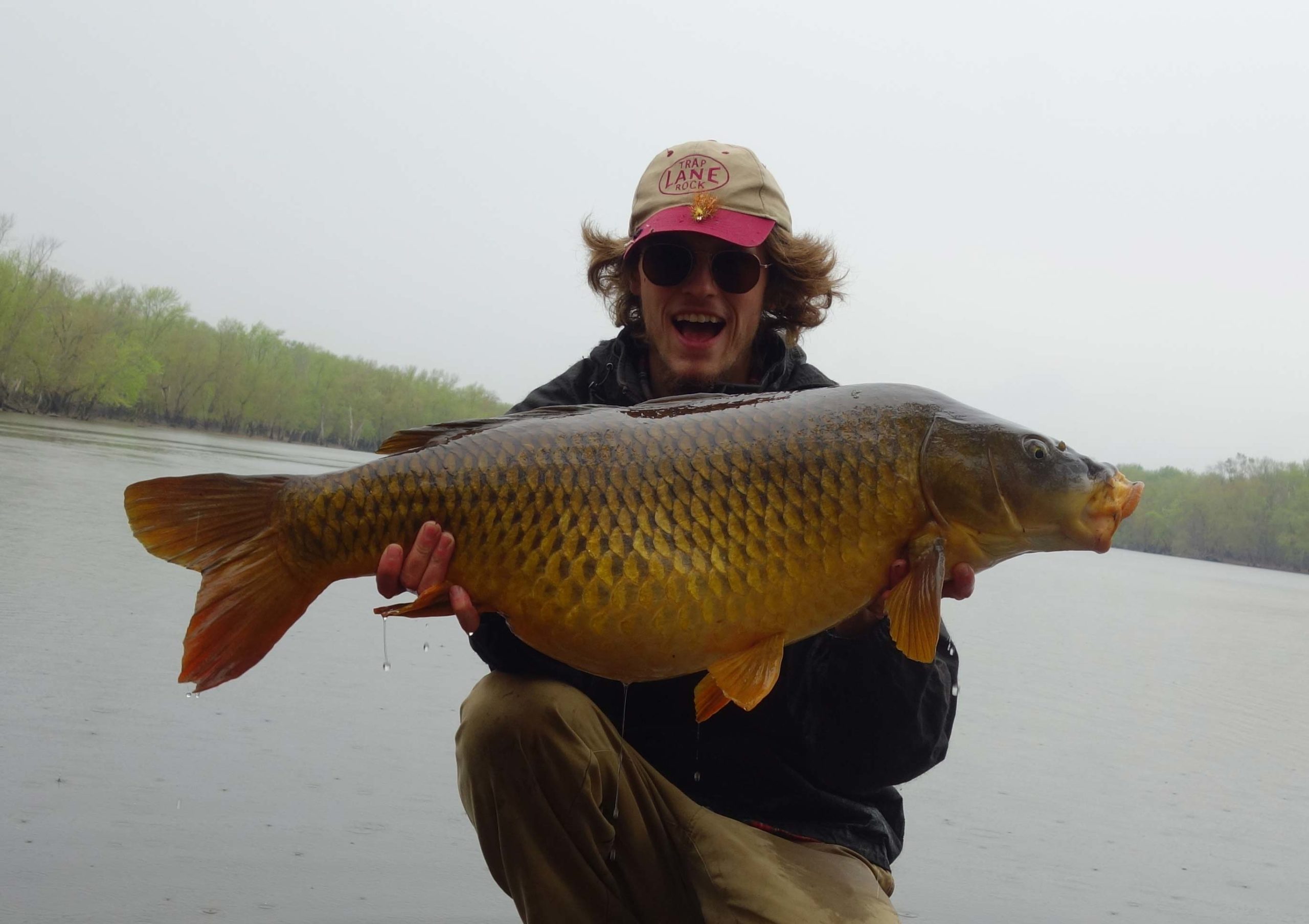
It’s not just dough balls and bait alarms anymore!
Carp run hard, test tackle, and are cunning creatures; and yet some anglers still dislike them, others have found out just how fun and challenging they are. Everything from the simple kernel of corn threaded onto a hook to the complex European baiting and rigging methods are finding footing in American carp waters, and one of the best fisheries in the U.S. is right here in New England, on the Connecticut River. Anglers travel from around the world to bait fish for carp in Southern New England. Fly casters have also thrown their hats in on pursuing these “rough fish”. Fly fishing for carp involves sight fishing in shallow water. One method that hasn’t yet taken hold on our side of the Atlantic is using lures on light and ultralight spinning gear. It seems that there are only a small handful of anglers doing it and it hasn’t yet ‘made waves’ on waters here at home.
This perplexed my friend and fishing partner Noah Johnson and myself. YouTube searches produced video proof of impressive carp caught on lures in Australia and we wondered if these methods would translate to our home waters. Noah and I are likeminded anglers who happen to gravitate to different tackle: I use fly gear almost exclusively, Noah usually fishes light spinning gear. This allows us to bounce ideas off of each other to gain new perspectives and modify our strategies on days when one is catching fish while the other isn’t. This was also ideal for developing light spinning gear strategies for carp. I already had a strong background getting New England’s resident carp to eat something fake and flavorless and Noah was already experimenting with light tackle and very small lures.
On Home Soil
Catching carp on the fly has been thoroughly refined over the last 25 years. Most fly carping involves stalking and sight-casting to fish in shallow water. Carp routinely enter very skinny water to feed. They can sometimes be seen tailing just like bonefish or permit. If a fly that imitates a dragon fly nymph, worm, crawfish, berry, or egg is cast gently in front of a carp, they will eat if they’re in the mood. Sometimes carp aren’t visible at all, but stir up bubbles from the bottom that signal their presence. I have had good success casting flies to these “bubblers” as we call them. There was little doubt that these strategies could be applied to spinning tackle.
We started out by finding lures that were appropriate counterparts to the flies that had worked for me. A slow rate of fall is ideal for carp, so lighter is better. These fish respond well to the sight of a bait falling slowly through the water column. A heavy jig also makes a bigger splash when it lands and that can spook finicky carp. Everything had to fit on jigs of just 1/16, 1/32, or 1/64 of an ounce! Eurotackle’s micro-finesse soft plastics were very appropriate. The Eurogrub is applicable when a worm fly would be appropriate, and the Metacraw fits the bill as a small crawfish likeness. Leland Trout Magnets are perfect for imitating a broad range of aquatic and terrestrial worms and larvae and already had a history of hooking carp. Small baitfish imitations ended up being quite productive too. Some of Noah’s best success ended up being on Bobby Garland’s Baby Shad and the Bass Pro Shops Stubby Butts.
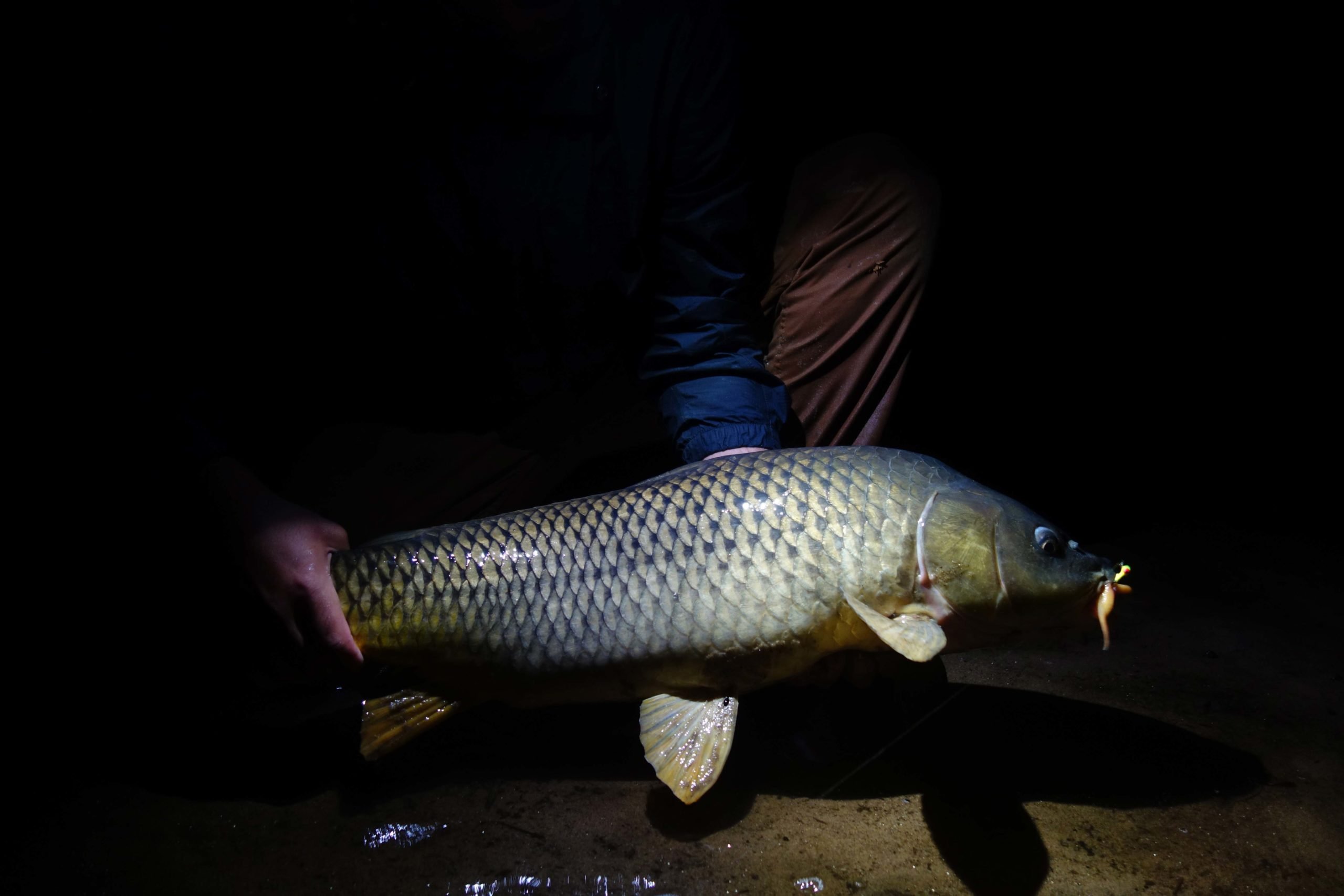
Gearing Up
Noah then had to get these jigs in front of a carp. Because light fly rods sized 5- and even as low as 3-weight have proven suitable for most carp, being able to cast light lures took precedence over fighting power. The 7-foot light Berkley Lightning Trout has been Noah’s go-to rod, though most rods rated for 1/32-ounce and lighter lures are appropriate for the task. There is certainly some utility for longer rods, both for leader protection – just like a long fly rod – and dropping jigs right in front of fish at close range.
A 1000 size reel with a smooth and reliable drag is perhaps most key. Noah keeps his drag light, very light in fact, because the ideal line for casting the tiny lures carp will hit is 6-pound, 8 carrier braid. The most widely available braid in that diameter is Daiwa J-Braid. Such light, fine diameter line even makes it possible to cast weighted flies on a spinning rod. The leader is 12-pound monofilament, rather than fluorocarbon. There haven’t been many issues getting fish to eat with that leader material and size, though I had my reservations. The elastic characteristic of nylon monofilament is preferable to stiff fluoro for absorbing the shock of angry carp head-shakes.
Finding Carp
With the right setup, the task now shifts to finding carp. Sight fishing is generally possible any time between mid-March and October. Early in the season, carp often move onto shallow mud flats seeking heat. Some of these fish merely sit or cruise around, and though those can be caught, they are less inclined to take than a fish that is visibly feeding. Look for waving tails, swirls, bubbles, and wakes. As the water warms up, more and more fish can be found feeding in the shallows. Sometimes there’s a big boom of activity right around the spawn, generally in June. Tailing fish found near spawning ones have a notable tendency to eat lures. Two days during the spawn in 2021, dozens of carp were hooked between Noah and myself on our local lake. The action can be almost unparalleled.
In March and on occasion late February, the ice thaws and the sun starts to warm shallow mud flats on lakes, ponds, and rivers throughout southern New England. This kickstarts the carp season, as common carp are one of the first species that move onto these shallow flats in large numbers. Dark mud bottom and depths of one to three feet are ideal, especially at the north end of a body of water. These areas see minimal shade throughout the day and warm up the fastest. They also provide good foraging grounds for hungry carp. Bright, warm, calm days draw in the most fish, but don’t rule out the cloudy or even rainy days as this can get the few fish lingering on a flat in a hungrier mood.
In March and April the carp spend large chunks of the day lazilly sunning themselves, and the fish doing this are very hard to catch. Look for active feeders rather than fish sitting still or slowly cruising just under the surface, as they will eat an artificial lure more readily. If there aren’t any active feeders and you don’t have the patience to wait around for one to start feeding, make the most delicate cast you can with a very slow sinking lure to one of the sun bathing fish. This is a situation where fly rods perform better, as it is easier to present an offering that sinks incredibly slowly at a longer distance. Extremely light jigs with a wide profile buoyant plastic can get the job done in a pinch, but finding those active feeders is a much better bet. These will often be on the periphery of large schools of carp. Be extremely cautious: spook one carp on the flat and you’ll have spooked them all.
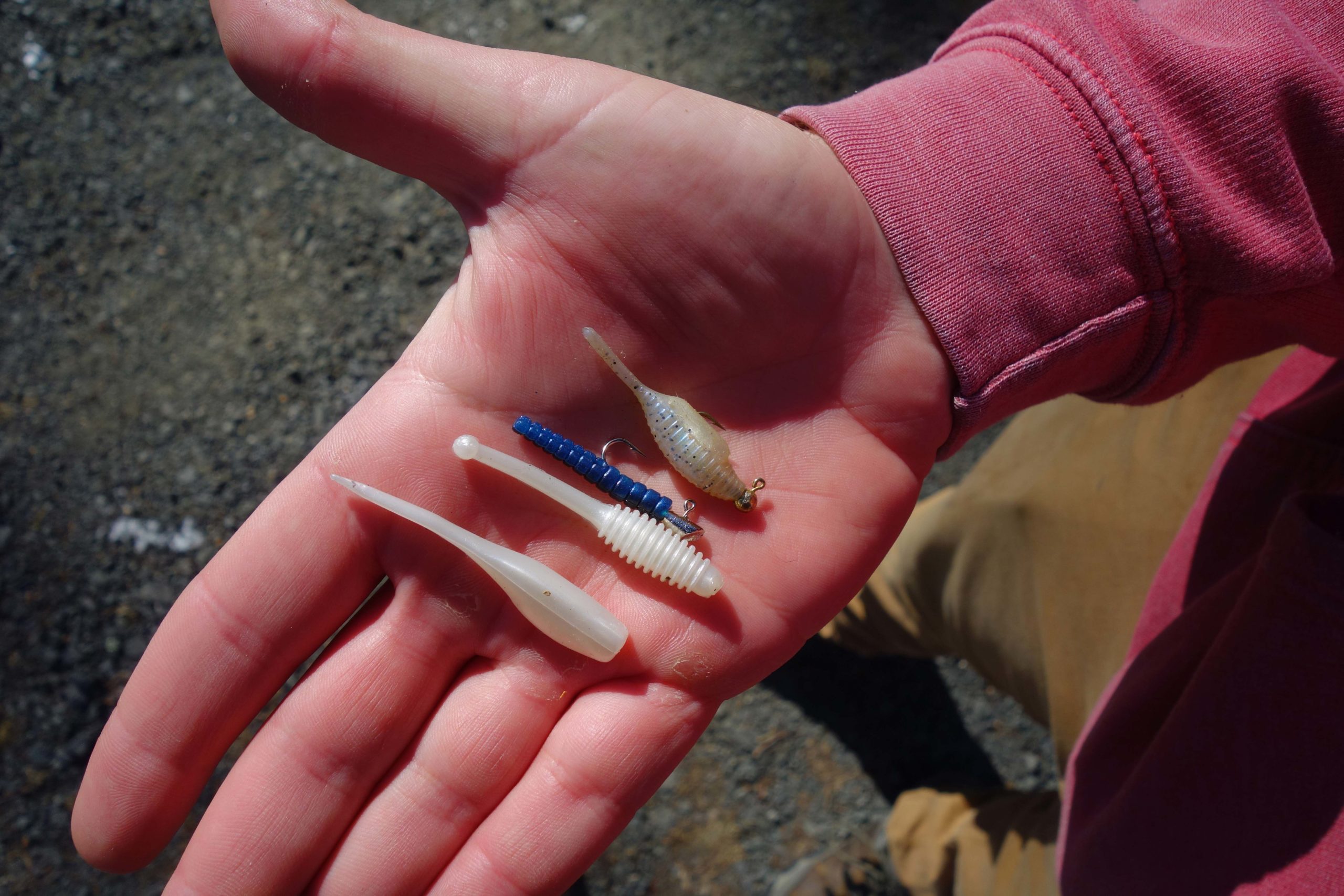
The Approach
Small skiffs, stand-up paddle boards, kayaks, and canoes are all good carp fishing platforms. Get just close enough that you can see the fish and have a really good idea of which direction it is facing, but no closer if you can avoid it. The carp should be facing towards or perpendicular (facing and moving to the right or left, but not away) to you – and this goes for wading or casting from the bank too – so that you don’t have to cast over its back.
An important thing to consider when using a boat to sight-cast to shy fish like common carp is staying quiet. The clunk of a push pole or paddle on the deck is bad news and will send fish running. Keeping a towel or foam padding on a kayak to prevent the paddle from making any banging noises when being laid down is a smart move. After painstakingly positioning the boat near feeding carp, it can feel downright devastating to look up just in time to see your fish spook, leaving nothing but a puff of mud in its place.
Now to get the fish you’ve found to eat a jig. Carp generally focus on feeding right in a small dinner-plate-sized space in front of them, so a cast that falls two feet short is no good. One strategy Noah adapted from fly fishing for carp is the ‘drag and drop’ presentation. Instead of casting the jig right to the fish, cast beyond it, then reel the lure to the fish while manipulating the rod angle to get it right in the fish’s feeding zone. It’s best to get the jig to fall just to the right or left of the fish’s mouth as they have a small blind spot directly in front of them. Fly anglers devised this method to make accuracy easier and to prevent splashing a fly down hard right on a fish’s head.
The Eat
Once the carp sees the jig falling to the bottom, it will either respond by moving to it and sucking it in or by spooking and swimming off. If it doesn’t see the jig it will simply keep feeding. The best move is to manipulate the jig just a little bit, one or two short hops. If the fish still doesn’t move, carefully retrieve and make another cast.
If the fish does eat the jig you will either see it or feel it, and a light lift of the rod with set the hook. Carp have soft mouths. “You don’t really need any hook-set power for carp” says Noah, and that’s part of how he gets away with a light drag, line, and light wire jig hooks. There’s no need to slam that hook home. Upon feeling the hook, the carp will generally take a run that will make that light drag sing. During this run, it is imperative to control the fish with rod angle adjustments and moving yourself rather than trying to turn the fish. Once it slows Noah lightly palms his reel to make gains. “If the fish suddenly runs there’s a good chance you won’t have time to adjust (your drag) lighter if you’ve already tightened it”. Progress is often slow with carp on this light tackle, but getting frustrated and trying to rush it will end badly. With practice, Noah has been able to cut his fight time down considerably.
If all has gone according to plan, you’ve just landed a carp that could weigh as much as 25 pounds (or even more) in your net… A carp that ate an artificial lure, no less! For those interested in catching big fish on very light tackle, this is a fantastic, underutilized, and readily available fishery. It was exciting to be a part of figuring even just a little bit of it out. Don’t turn a blind eye to the ‘lowly’ carp, these fish are powerful, grow to immense sizes and will test your patience and skill like no other fish that swims in New England waters.

